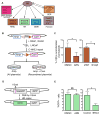Androgen receptor signaling regulates DNA repair in prostate cancers
- PMID: 24027196
- PMCID: PMC3888815
- DOI: 10.1158/2159-8290.CD-13-0172
Androgen receptor signaling regulates DNA repair in prostate cancers
Abstract
We demonstrate that the androgen receptor (AR) regulates a transcriptional program of DNA repair genes that promotes prostate cancer radioresistance, providing a potential mechanism by which androgen deprivation therapy synergizes with ionizing radiation. Using a model of castration-resistant prostate cancer, we show that second-generation antiandrogen therapy results in downregulation of DNA repair genes. Next, we demonstrate that primary prostate cancers display a significant spectrum of AR transcriptional output, which correlates with expression of a set of DNA repair genes. Using RNA-seq and ChIP-seq, we define which of these DNA repair genes are both induced by androgen and represent direct AR targets. We establish that prostate cancer cells treated with ionizing radiation plus androgen demonstrate enhanced DNA repair and decreased DNA damage and furthermore that antiandrogen treatment causes increased DNA damage and decreased clonogenic survival. Finally, we demonstrate that antiandrogen treatment results in decreased classical nonhomologous end-joining.
Significance: We demonstrate that the AR regulates a network of DNA repair genes, providing a potential mechanism by which androgen deprivation synergizes with radiotherapy for prostate cancer.
©2013 AACR.
Conflict of interest statement
Conflict of interest statement: CLS and JW are co-inventors of ARN-509.
Figures




Comment in
-
Prostate cancer: understanding why.Nat Rev Cancer. 2013 Nov;13(11):754. doi: 10.1038/nrc3615. Epub 2013 Oct 10. Nat Rev Cancer. 2013. PMID: 24108098 No abstract available.
-
Androgen receptor signaling fuels DNA repair and radioresistance in prostate cancer.Cancer Discov. 2013 Nov;3(11):1222-4. doi: 10.1158/2159-8290.CD-13-0679. Cancer Discov. 2013. PMID: 24203954
References
-
- Bolla M, Gonzalez D, Warde P, Dubois JB, Mirimanoff RO, Storme G, et al. Improved survival in patients with locally advanced prostate cancer treated with radiotherapy and goserelin. N Engl J Med. 1997;337:295–300. - PubMed
-
- Jones CU, Hunt D, McGowan DG, Amin MB, Chetner MP, Bruner DW, et al. Radiotherapy and short-term androgen deprivation for localized prostate cancer. N Engl J Med. 2011;365:107–18. - PubMed
-
- Wo JY, Zietman AL. Why does androgen deprivation enhance the results of radiation therapy? Urol Oncol. 2008;26:522–9. - PubMed
Publication types
MeSH terms
Substances
Grants and funding
LinkOut - more resources
Full Text Sources
Other Literature Sources
Medical
Research Materials

